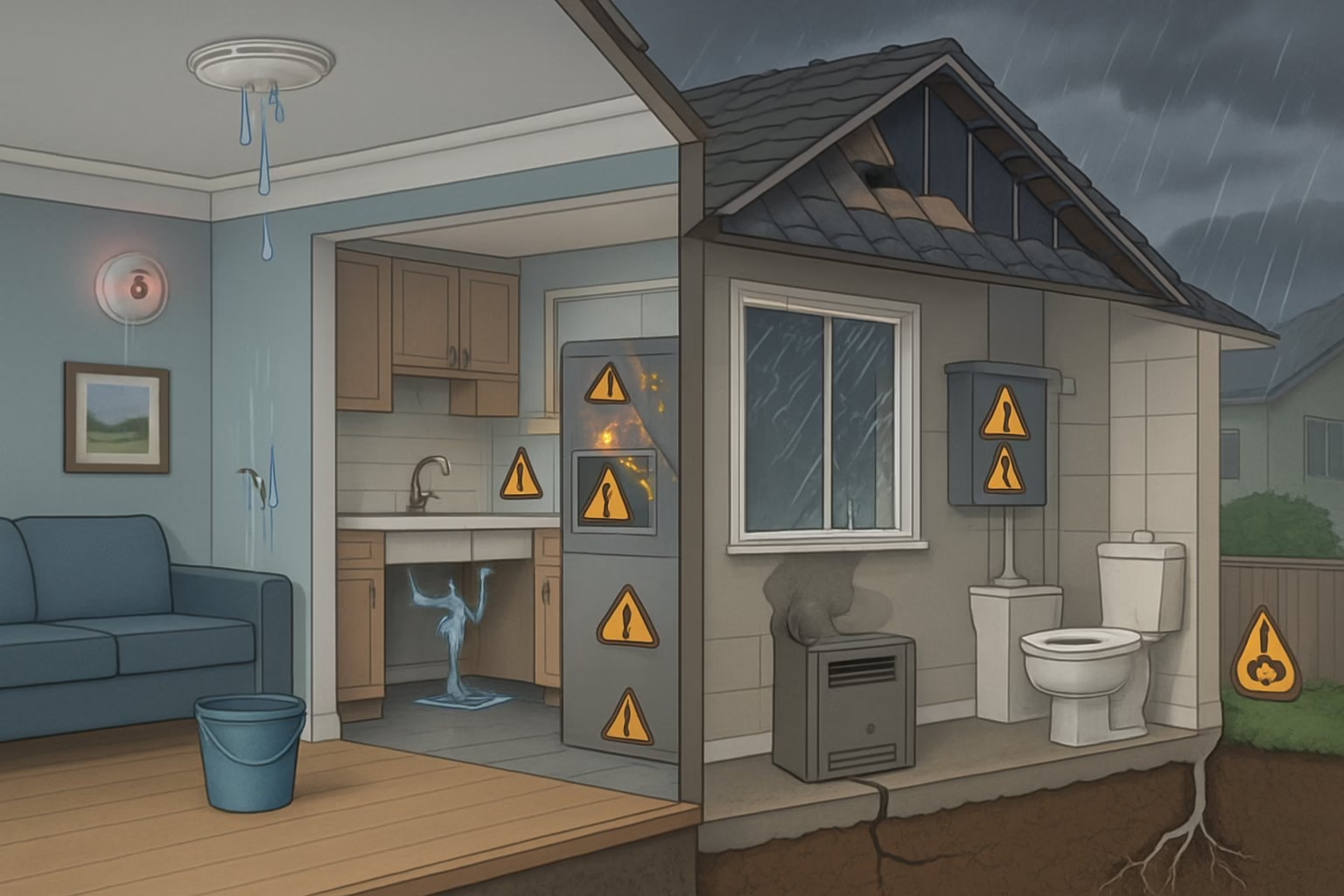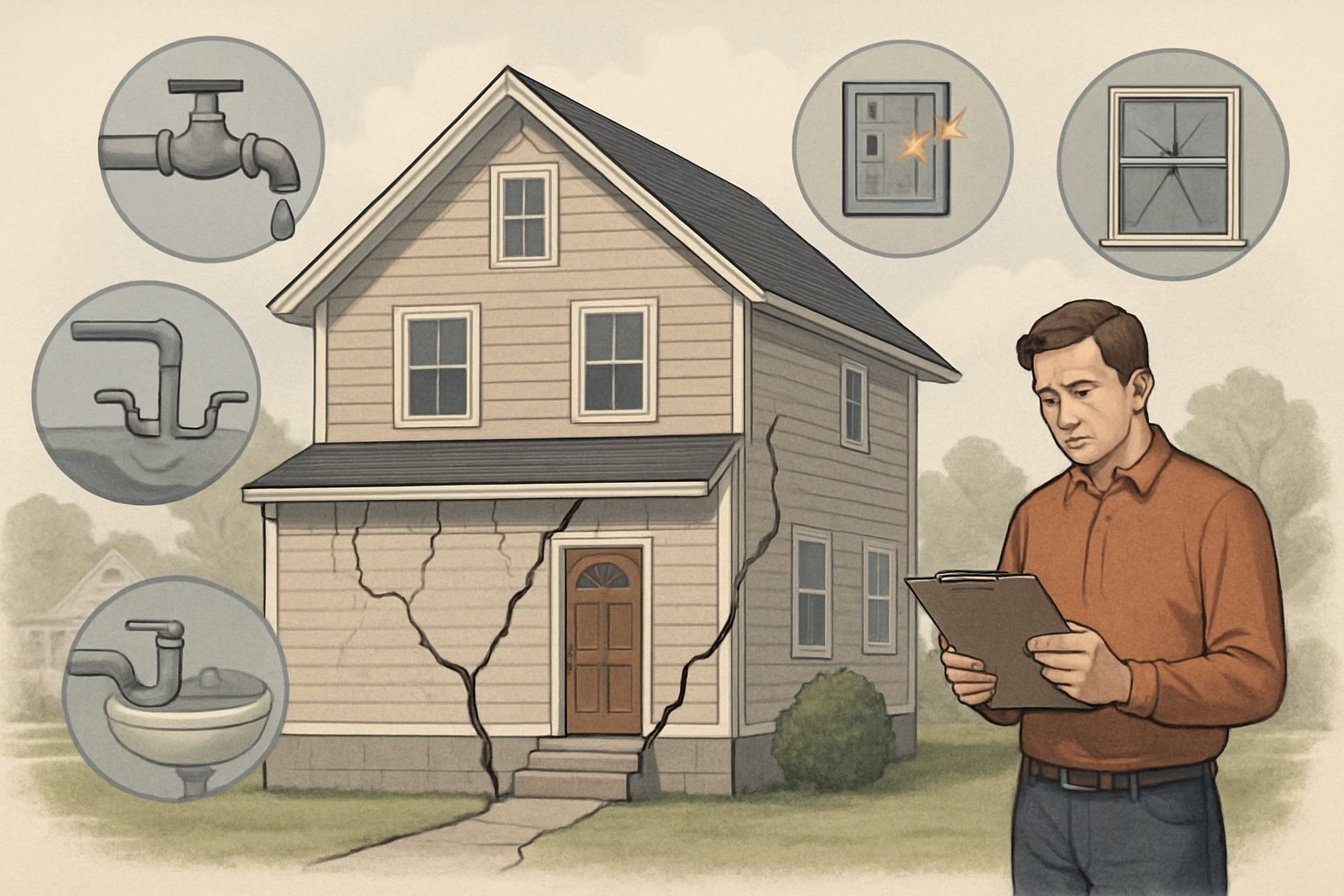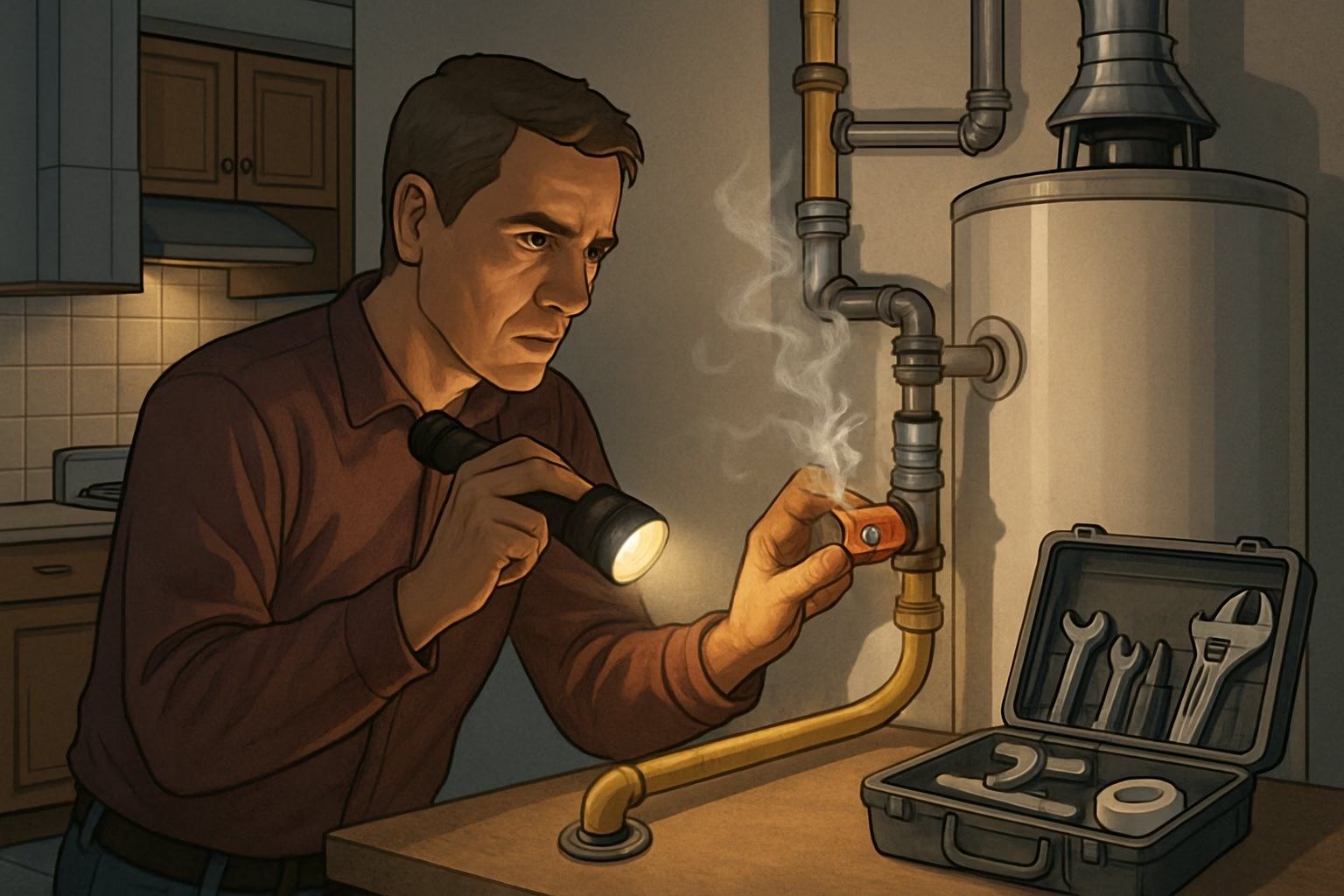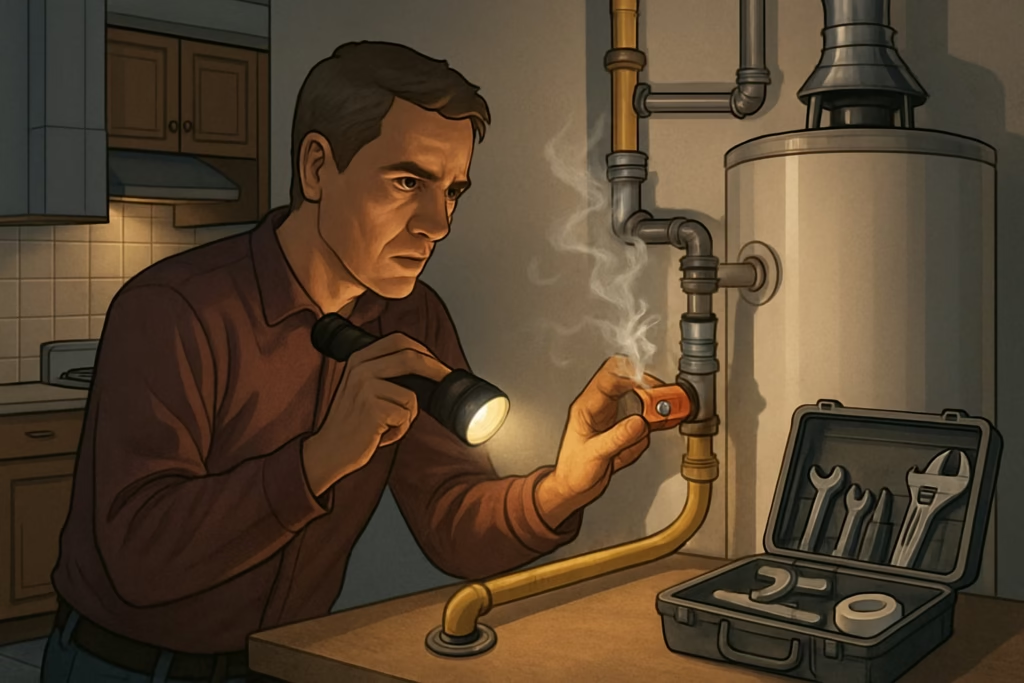Owning a home brings its share of surprises. Sometimes, those surprises are costly or even dangerous.
Some repairs can wait, but others demand immediate action. If you want to keep your family safe and avoid massive bills, you can’t ignore certain problems.

Letting some home emergencies slide is just asking for trouble. Water pouring through your ceiling, sparking outlets, or a burst pipe can wreck your home and put everyone in danger.
1) Roof leaks causing water damage
Roof leaks are a nightmare. Even a tiny drip can turn into a huge headache fast.
Water seeps into the wood, making beams and posts rot over time. That kind of damage can sneak up on you and get expensive.
Ceilings and walls don’t stand a chance against steady leaks. First, you’ll see ugly stains, then the drywall softens and, eventually, might collapse.
Insulation gets soggy and useless. You end up paying more to heat or cool your place, and sometimes you have to rip it all out and start fresh.
Mold loves damp spots. Give it a day or two and you’ll have a health hazard on your hands. Mold removal isn’t cheap, either.
Water near electrical wires? That’s a recipe for a fire or a blackout. It’s just not worth the risk.
Honestly, it’s smart to check your roof and attic every year, especially after a big storm. Missing shingles, water stains, or even weird dripping noises are red flags.
Jumping on a leak early saves you money and hassle. Wait too long, and you’re looking at major repairs.
2) Burst or leaking pipes
Burst pipes are a homeowner’s worst enemy. Water can ruin everything in minutes if you don’t act fast.
Freezing weather often causes pipes to burst, but rust and physical damage can do it too. Pipes don’t last forever, unfortunately.
Watch for water pooling under sinks, damp spots on walls, or a sudden drop in water pressure. These are all signs you’ve got a problem brewing.
The EPA says household leaks waste about 10,000 gallons of water per home every year. That’s wild—some homes waste over 90 gallons a day just from leaks.
If a pipe bursts, shut off the main water valve right away. Kill the power to any wet areas if you can do it safely. Grab buckets and towels to control the mess as best you can.
Don’t shrug off small leaks. Even a slow drip can turn into a flood and wreck your floors, walls, or stuff you care about.
Let a plumber handle big repairs. You might slow things down with a patch, but real fixes need expertise and the right tools.
3) Malfunctioning electrical wiring
Bad wiring is scary stuff. It can start fires, shock you, or fry your electronics.
Flickering lights usually mean loose connections or overloaded circuits. If an outlet feels warm, that’s not normal—it’s overheating and could start a fire.
Dead outlets or buzzing from the panel are big warning signs. If your breakers trip all the time, your system is overloaded.
Smell something burning near a switch or outlet? Stop using it. Overheating wires are a fire waiting to happen.
Honestly, don’t mess with electrical repairs unless you really know what you’re doing. Even swapping out an outlet can go wrong in a hurry.
Electricians have the training and tools to fix things safely. They also know the codes and what’ll pass inspection.
Your insurance might not cover damage from DIY electrical work. That’s a risk most people shouldn’t take.
See any of these warning signs? Call a pro. Waiting just makes it more dangerous and expensive.
4) Foundation cracks

Foundation cracks are a big deal. Even small ones can get worse if you ignore them.
If you spot a crack wider than a tenth of an inch, call in a pro. Smaller cracks? Measure them and keep an eye out for changes.
Watch for uneven floors, doors that stick, or new cracks in your drywall—these are all bad signs.
The foundation holds up your whole house. If it fails, you’ll see walls crack and floors go wonky. No one wants that.
Horizontal cracks or anything wider than three-sixteenths of an inch? That’s urgent. Vertical cracks might not be as bad, but don’t ignore them either.
Foundation repairs are cheaper if you catch problems early. Contractors can tell you if it’s just cosmetic or something more serious.
It’s smart to check your foundation a few times a year. That way, you’ll spot issues before they get out of hand.
5) Gas leaks

Gas leaks are no joke. They can start fires, cause explosions, or make you sick in no time.
If you smell rotten eggs or sulfur, that’s the gas company’s way of warning you. That smell means get out, now.
Listen for hissing near your gas lines or appliances. Dead plants near your gas meter? That could mean a leak too.
If you think there’s a leak, leave the house right away. Don’t flip switches or use your phone inside—any spark could set things off.
Once you’re safe, call the gas company or 911. They’ll send someone who knows what they’re doing.
Don’t try to hunt down the leak yourself. Never use matches or lighters to check for gas. That’s just asking for disaster.
Gas companies respond fast to leaks. Their techs have special gear to find and fix the problem safely.
Get your gas appliances checked once a year by a pro. It’s a small hassle for a lot of peace of mind.
6) Sewer backup or drain clog
A sewer backup is a nightmare. It brings bacteria and contaminated water into your home, and the cleanup isn’t cheap.
If more than one drain backs up at the same time, your main sewer line could be blocked. Water showing up in weird places—like your shower when you flush—means trouble.
Gurgling sounds from drains or strong sewer odors are warnings you shouldn’t ignore.
Grease, food scraps, and random objects cause most clogs. Sometimes, tree roots break into pipes and make things worse.
If you get a backup, stop using water right away. Stay away from any contaminated water and call a plumber ASAP.
Throw grease and coffee grounds in the trash, not down the sink. A little prevention goes a long way.
Regular drain checks can catch issues early. Fixing a small clog beats replacing your whole sewer line, any day.
7) Heating system failure in cold weather
Losing heat in winter can get dangerous fast. The temperature inside drops, and that’s risky for everyone—especially kids and seniors.
If your heat’s out, check the thermostat first. Make sure it’s set to “heat” and the batteries aren’t dead.
If you smell gas or something burning, shut the system off and get out. Weird noises from the furnace are another red flag.
Frozen pipes are a real risk when your home gets too cold. Water expands as it freezes and can blow out your pipes, causing even more damage.
If your heater keeps turning on and off, that’s called short cycling. It means something’s wrong and you’re not getting enough heat.
Call a pro if the house is getting too cold. Waiting could mean bigger repairs and health risks.
8) Garage door not closing securely
If your garage door won’t close, you’re basically leaving an open invitation for trouble. It’s a huge security risk.
Misaligned safety sensors are a common cause. These sensors stop the door if there’s something in the way.
Bent or damaged door panels can also prevent it from closing. Weather and accidents can warp them over time.
Broken springs make the door too heavy for the opener. If that’s the problem, don’t try to force it.
First, check for anything blocking the door’s path. Even a small object can mess with the sensors.
Look at the tracks too. Bent tracks can stop the door from moving smoothly.
If you can’t fix it with these checks, it’s time to call a pro. Messing with springs or electrical parts can be dangerous.
Don’t wait to fix a garage door that won’t close. The longer it’s open, the more you risk theft or damage.
9) Broken smoke or carbon monoxide detectors
Smoke and carbon monoxide detectors are life savers. If they’re not working, you might not get a warning in time.
A chirping detector usually just needs a new battery. Swap it out every six to twelve months.
If a detector won’t work at all, that’s a big problem. Most fatal house fires happen in homes without working alarms.
Test your detectors every month. Just press the button and listen for the alarm—it’s quick and easy.
Hard-wired units can fail from electrical issues or dust. Sometimes you need an electrician to fix or replace them.
Don’t ignore a detector that’s acting up. Change the battery right away if it’s chirping, and clean off dust to avoid false alarms.
If your detector is over ten years old, replace it. They get less reliable with age and might not work when you need them.
Professional installation helps make sure everything’s up to code. A tech can also check your current setup and suggest improvements for better safety.
10) Mold growth from moisture intrusion
Mold takes off fast when water sneaks into a house. Sometimes it shows up just a day or two after water damage.
Water slips in through roof leaks, busted pipes, or flooding. Bad drainage around the foundation also lets moisture in.
Mold isn’t picky—it’ll feed on wood, drywall, carpet, or even old wallpaper. All those organic materials make great snacks for it.
If you catch a musty smell or spot dark patches, don’t brush it off. Those are early warnings that mold’s moving in.
Even tiny leaks can cause big headaches. Mold loves to hide inside walls and under floors where you can’t see it.
Over time, mold chews away at the structure. Wood and other materials get weaker the longer it’s left alone.
As mold spreads, people can start having trouble breathing or get allergy symptoms. It’s a real risk, especially for anyone sensitive.
Fix the source of moisture right away. Cleaning off visible mold doesn’t work if water keeps coming in.
If mold covers a large area, it’s probably time to call in the pros. Homeowners can usually tackle small spots—think less than 10 square feet—on their own.
Understanding the Risks of Ignoring Emergency Repairs
If you put off urgent repairs, you’re basically inviting three big problems: damage spreads and gets pricier, safety hazards get worse, and repair bills balloon over time.
Potential Damage to Property
Let a small problem sit, and it can turn into a disaster. A tiny roof leak can wreck ceiling drywall, insulation, and even wooden beams in just a few weeks.
Water damage doesn’t waste time—it moves fast. Burst pipes can flood several rooms, destroying floors, furniture, and even electrical systems. Foundation cracks let water sneak in, leading to mold and weakening the structure.
Electrical issues are no joke. Faulty wiring can spark fires in walls or attics. Gas leaks from appliances or lines? Those can cause explosions.
HVAC breakdowns hit the whole house. If the heat goes out in winter, pipes might freeze and burst. Broken A/C can crank up humidity and give mold a chance to grow.
Damage spreads in all sorts of ways:
- Roof leaks: Water travels through walls and damages multiple floors
- Plumbing issues: Floods destroy flooring, cabinets, and appliances
- Foundation problems: Cracks widen and affect the entire structure
- Electrical faults: Fire damage spreads quickly through homes
Safety and Health Concerns
Emergency repairs often come with real safety risks. Gas leaks can cause carbon monoxide poisoning or even explosions. Bad electrical systems are a fire and electrocution risk.
Structural damage makes a home dangerous to live in. Broken stairs or railings, sagging floors, or cracked walls can give way without warning.
Water damage brings health problems too. Mold can show up within a day or two in damp spots. If you have asthma or allergies, mold in the vents can make things much worse.
Broken security systems leave your home open to break-ins. Damaged doors or windows just make it easier for someone to get in.
HVAC issues mess with air quality. Broken systems can move dust, allergens, and even harmful gases throughout the house.
Financial Consequences
Wait too long to fix something, and you’ll pay for it—literally. What could’ve been a $500 roof patch turns into a $15,000 roof replacement when the structure gets soaked.
Insurance might not help if you ignore obvious problems. Companies often deny claims when homeowners don’t act fast enough.
Emergency repairs on weekends or holidays cost way more. After-hours calls can be 50-100% pricier than regular visits. And if there’s a disaster, good luck finding a contractor who isn’t booked solid.
Property value drops if your house has visible damage or safety issues. Buyers avoid homes with foundation cracks, electrical messes, or water stains.
Just look at how fast costs pile up:
| Repair Type | Early Fix Cost | Delayed Fix Cost |
|---|---|---|
| Small roof leak | $200-500 | $5,000-15,000 |
| Minor plumbing leak | $100-300 | $2,000-8,000 |
| Electrical outlet issue | $150-400 | $1,500-5,000 |
Lost time from work only adds to the headache. Sometimes you have to move out while contractors fix the mess.
When to Call a Professional
Some repairs just aren’t DIY-friendly. If you’re not sure or don’t have the right tools, it’s safer (and cheaper in the long run) to call in a pro.
Identifying Severe or Structural Problems
Foundation problems always need a professional. Cracks wider than a quarter-inch, horizontal cracks, or ones that keep growing? Don’t mess with those yourself.
Electrical issues like sparking outlets, burning smells from the panel, or flickering lights everywhere are serious. Only licensed electricians should handle them.
Major plumbing disasters—burst pipes, sewer backups, water heater failures—can flood your place in minutes. Professional plumbers know how to stop the damage fast.
Structural damage in walls, ceilings, or the roof needs a pro’s eye. Sagging ceilings or bowing walls might mean the home isn’t safe. Structural engineers and contractors can tell you what’s really going on.
Choosing Qualified Service Providers
Always check licenses and insurance before hiring anyone. Most states require it for electrical, plumbing, and general contracting. Insurance keeps you covered if something goes wrong.
Get a few quotes for big jobs. Three estimates help you spot a fair price and see what’s included. Ask for everything in writing—materials, labor, timeline.
Ask for references from recent customers. Good contractors don’t mind sharing. Ask past clients about the work, if it was done on time, and how clean things were after.
Look for emergency availability if you’re dealing with urgent repairs. Some companies offer 24/7 service for things like burst pipes or electrical failures.
Frequently Asked Questions
People usually have a ton of questions about structural damage, gas leaks, electrical dangers, water messes, HVAC failures, and sewage problems. These can threaten your safety and cost you big if you ignore them.
What are the signs of a critical structural failure that requires immediate attention?
Watch for large cracks in walls that keep getting wider. If doors or windows suddenly stick or won’t shut, your foundation might be shifting.
Sagging or bouncy floors are another red flag. Foundation cracks wider than a quarter-inch need a pro’s attention right away.
If walls lean or bulge, that’s serious. Cracking noises from the frame are never good—call for an emergency inspection.
How can I identify and address a gas leak within the home?
If you smell rotten eggs or sulfur, that’s usually a gas leak. Don’t ignore it, ever.
Listen for hissing sounds near gas appliances or pipes. Dead plants around outdoor gas lines can mean a leak too.
If you suspect gas, get everyone out immediately. Don’t flip switches or do anything that could spark.
Call the gas company from outside. Wait until the pros say it’s safe to go back in.
Which electrical issues pose serious risks and warrant emergency repairs?
Sparks from outlets or switches are a big fire risk. Turn off the power to those areas right away.
If you notice burning smells from panels or outlets, that’s dangerous. Flickering lights throughout the house can mean wiring trouble.
Hot outlet covers or switch plates aren’t normal. If your circuit breaker keeps tripping, your system’s likely overloaded.
Getting a shock from an appliance or switch? That needs immediate attention—these problems can cause fires or worse.
What should homeowners do when they notice major water leaks?
If you spot a big leak, shut off the main water supply fast. Know where that valve is before you ever need it.
Burst pipes can flood a house in minutes. Move furniture and valuables out of harm’s way as quickly as you can.
Take photos for insurance. Call a plumber and your insurance company as soon as possible.
Standing water needs to go within 24 hours to avoid mold. For big leaks, you might need to call a water damage specialist.
How can you tell if your HVAC system needs urgent repair?
If your HVAC is making weird noises—grinding, squealing, whatever—it could be failing. If a carbon monoxide detector goes off, that’s a red flag for gas leaks in the heating system.
No heat in winter or no A/C during a heatwave is a real safety issue. If your gas furnace has a yellow flame instead of blue, it’s burning wrong.
Strong gas smells near heating equipment? Shut it down right away. Ice on the A/C during use usually means a refrigerant leak.
If the system keeps cycling on and off, it’s wasting energy and could break down for good. Waiting only makes things pricier to fix or replace.
What actions should be taken if a sewage backup occurs in the home?
Sewage backups can turn into serious health hazards in no time. If this happens, avoid touching the contaminated water and grab some protective gear if you really have to go near it.
First things first—shut off the electricity in any affected rooms. Nobody wants to risk getting shocked. Definitely skip using household fans; they’ll just blow nasty bacteria all over the place.
Honestly, it’s best to call in professional cleanup services right away. These folks have the right equipment and know-how to handle the mess safely.
Toss out anything that got contaminated and can’t be thoroughly cleaned. Before you start the cleanup, take photos or videos of everything for your insurance claim. You’ll thank yourself later.

